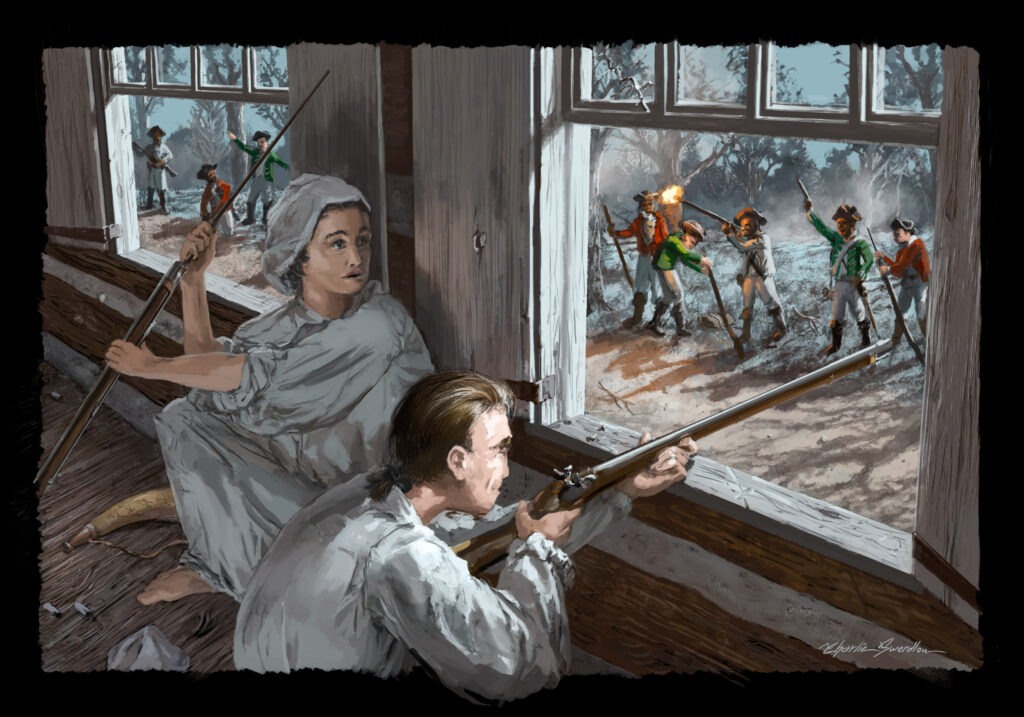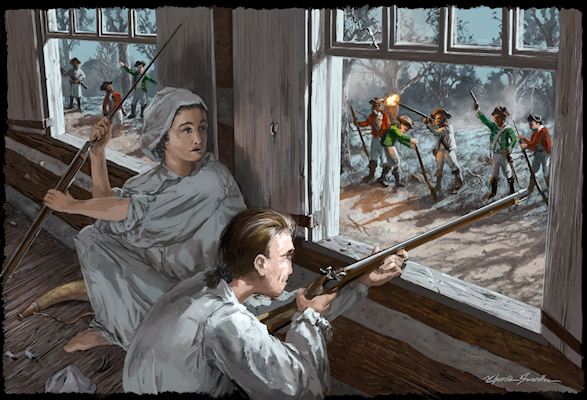Original illustration exclusively for Monmouth Timeline, ©2021 by Charles Swerdlow, all rights reserved.
In the years following the Battle of Monmouth, residents of Monmouth County engaged in an escalating civil war between residents siding with the Revolutionary cause, and residents loyal to the king. By 1780, the Patriots has succeeded in driving the most committed Loyalists from their homes, into exile in a community of tents and cabins known as “Refugeetown” on the British stronghold at Sandy Hook. One Monmouth Militia leader, Captain Joshua Huddy, was known for being especially savage toward Loyalists, often preferring execution to imprisonment or other treatment.
The community of exiled Loyalists at Refugeetown also included a number of runaway slaves and other African Americans seeking the protection of the British. Many were organized into military units such as the Black Pioneers, the Jamaica Volunteers, and the Negro Horse, though there is no evidence these units saw any fighting. Another group called themselves the Black Brigade. They were led by the former Colts Neck slave Titus, who had run away to join the British army when they promised slaves their freedom in return for taking up the Loyalist cause. Titus eventually became known as Colonel Tye, having earned a reputation for cunning and bravery as a military leader. Tye led groups of raiders, including the Black Brigade, white loyalists, and British soldiers, into Monmouth County on numerous occasions to forage for supplies, take hostages for use in prisoner exchanges, and strike fear into the hearts of Patriots. He was very successful at all three.
On Sunday, September 1, 1780, a dramatic showdown took place in the early morning hours, at the Colts Neck tavern where Joshua Huddy lived. Colonel Tye led a group of approximately 30 raiders deep into Monmouth County’s interior in the dark. He and his men, being mostly locals, knew the roads, waterways, and Indian trails, and so were able to strike almost anywhere, in total secrecy and surprise.
On that morning, Huddy was alone in the house save for a servant, Lucretia Emmons, who was “about 20 years of age.” Tye’s men quietly surrounded the house. When one of Tye’s men broke a window, seeking to enter the house and make quick work of the kidnapping, Huddy awoke and began firing muskets from different windows, with Emmons following behind, reloading as fast as she could. This convinced the Loyalists that the house, known to be a militia station, held more than a single foe, and Huddy held off the raiders for several hours. Ultimately Huddy was forced to surrender when they began to burn down his house. Tye agreed to allow Emmons to go free and extinguish the fire, and Huddy then agreed to surrender.

Huddy and anything useful from the house as well as cattle and sheep were taken to the shore where they were in the process of being loading onto boats to return to Sandy Hook, which was an island at that time. A party of Middletown militia, hearing reports of the sustained gunfire from Colts Neck, caught up with them and opened fire, reportedly killing eight or nine men. Huddy exploited the confusion – and his capsizing boat – to jump overboard and swim to safety, taking a bullet from his own rescuers in the process. Colonel Tye fared worse – wounded in the wrist, probably by Huddy himself during the initial skirmish, he died from tetanus and gangrene several days later.
The details of the story of the battle at Huddy’s tavern in Colts Neck come from a single source, a letter from Nathaniel Scudder to his son. Scudder was a doctor and a member of the Continental Congress, so he is considered a relatively reliable source, but in his letter, Scudder said, “I have this only from Report, therefore cannot vouch for it.” So, while it is possibly the most amazing story in the 400 years of Monmouth County history, it is not necessarily a matter of historic fact. There is more support for Huddy’s escape and the clash at the beach, so it is a fact that Colonel Tye did succeed, momentarily, in capturing Joshua Huddy, but Huddy got away, and while both men were wounded, Tye’s wound proved fatal, while Huddy would soldier on, at least for a little while longer.
This story is part of the Joshua Huddy Timeline as well as the Colonel Tye Timeline. Click here for the next Joshua Huddy story; Click here for the final Colonel Tye story.
Sources:
Adelberg, Michael S. (2010). The American Revolution in Monmouth County. The History Press, Charleston, S.C., P. 75-97.
Allen, Thomas B. (2010). Tories: Fighting for the King in America’s First Civil War. HarperCollins, New York, N.Y. P. 316-320.
Ellis, Franklin. (1885). History of Monmouth County, New Jersey, Part 1. R. T. Peck & Co., Philadelphia, Penn., 1885, P. 214. Reprinted in 2017 by The Apple Manor Press, Markham, Va.
Hodges, Russell Graham. (1997). Slavery and Freedom in the Rural North: African Americans in Monmouth County, New Jersey, 1665-1865. A Madison House Book, Rowman & Littlefield, Lanham, Md., P. 91-107.
Saretzky, Gary D. (2004). The Joshua Huddy Era: Documents of the American Revolution. Catalog of the Exhibition at Monmouth County Library Headquarters, Manalapan, N.J. October, 2004; Revised November 2004. Produced by the Monmouth County Archives. Available: https://www.monmouthcountyclerk.com/archives/events-exhibits/2004-documents-of-the-american-revolution-joshua-huddy-era/
Image: The Fatal Showdown Between Colonel Tye and Joshua Huddy, original illustration. Commissioned by Monmouth Timeline, ©2021, Charlie Swerdlow, History Depicted.


Leave a Reply